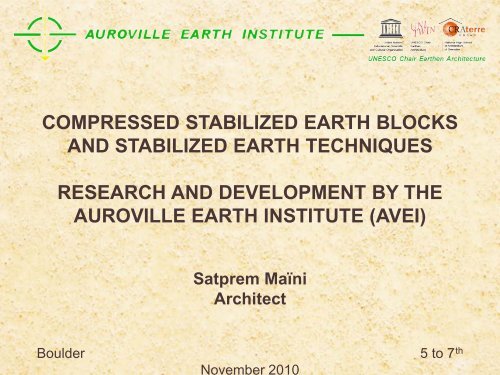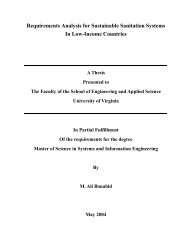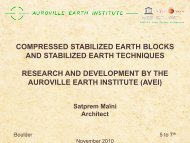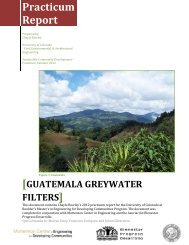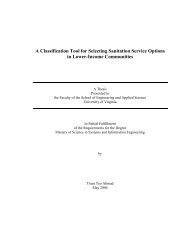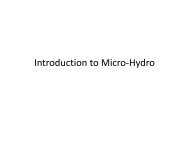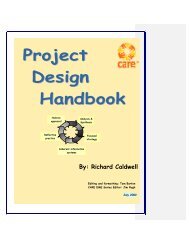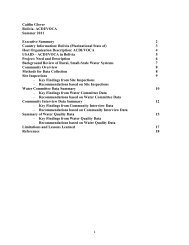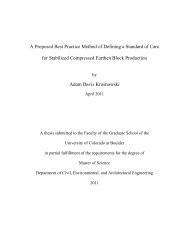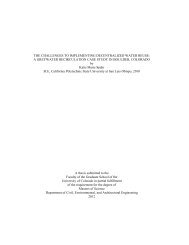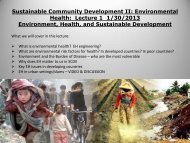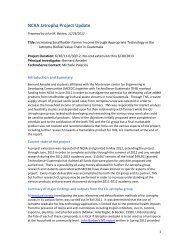Create successful ePaper yourself
Turn your PDF publications into a flip-book with our unique Google optimized e-Paper software.
COMPRESSED STABILIZED EARTH BLOCKS<br />
AND STABILIZED EARTH TECHNIQUES<br />
RESEARCH AND DEVELOPMENT BY THE<br />
AUROVILLE EARTH INSTITUTE (AVEI)<br />
<strong>Satprem</strong> Maïni<br />
Architect<br />
Boulder 5 to 7 th<br />
November 2010
SUMMARY<br />
Introduction<br />
<strong>Auroville</strong> Earth Institute & Resources<br />
Management<br />
1. Compressed stabilised earth blocks (CSEB)<br />
A. Research on CSEB: Equipment and<br />
products<br />
B. Data on CSEB<br />
C. Disaster resistance with CSEB<br />
D. E’Block project<br />
2. Stabilized earth techniques<br />
A. Stabilized rammed earth foundations<br />
B. Various composites techniques<br />
3. Diversity of earthen buildings with CSEB<br />
A. Projects by various architects<br />
B. Architectural research and building<br />
methods by AVEI<br />
C. Projects' case studies of AVEI<br />
2
INTRODUCTION<br />
THE AUROVILLE EARTH<br />
INSTITUTE<br />
3
�AVEI was founded in 1989 by HUDCO, Government of India<br />
�Thirteen awards: two international awards and eleven Indian ones<br />
�Representative and Resource Centre for Asia of the UNESCO Chair<br />
“Earthen Architecture, Constructive Cultures and Sustainable Development”<br />
�BASIN South Asia (Building Advisory Service and Information Network)<br />
Applied<br />
Researches<br />
Training &<br />
Education<br />
Publication<br />
(33 today)<br />
ACTIVITIES<br />
Consultancy<br />
worldwide<br />
Constructio<br />
n worldwide<br />
�Researching, developing and promoting earth-based technologies<br />
�Disseminating and transferring earth architecture worldwide ⇒ 30 countries<br />
�Training more than 6,500 people from 67 countries<br />
Heritage<br />
conservation<br />
4
The <strong>Auroville</strong> Earth Institute attempts to link the ancestral<br />
tradition of raw earth building with the modern technologies<br />
of stabilised earth.<br />
The <strong>Auroville</strong> Earth Institute attempts to giving people the<br />
possibility to build themselves their own habitat with earth.<br />
The <strong>Auroville</strong> Earth Institute shows that earth, as a building<br />
material, can be used for creating a modern, progressive,<br />
eco-friendly and safe habitat.<br />
Compressed Stabilised Earth Blocks (CSEB)<br />
is today the technology used the most in <strong>Auroville</strong>.<br />
5
Actions in 30 countries:<br />
1983: Tunisia – 1986: Egypt & Germany – 1987: France, Somalia & Ivory Coast – 1988:<br />
Australia, Haiti & Saudi Arabia – 1989 to 2009: India – 1990: Zaire – 1993: Eritrea – 1996:<br />
Turkey – 1997: Brazil – 1999: Sri Lanka & Tibet – 2000: Niger & Burkina Faso – 2003: Saudi<br />
Arabia – 2004: Iran – 2006: Israel, Portugal & Colombia – 2007: South Africa, Ethiopia,<br />
Mexico & Texas – 2008: Nepal & Libya – 2009: Tanzania & Nepal –<br />
2010: Algeria, Haiti, Egypt, USA<br />
6
Actions in 30 countries:<br />
1983: Tunisia – 1986: Egypt & Germany – 1987: France, Somalia & Ivory Coast – 1988:<br />
Australia, Haiti & Saudi Arabia – 1989 to 2009: India – 1990: Zaire – 1993: Eritrea – 1996:<br />
Turkey – 1997: Brazil – 1999: Sri Lanka & Tibet – 2000: Niger & Burkina Faso – 2003: Saudi<br />
Arabia – 2004: Iran – 2006: Israel, Portugal & Colombia – 2007: South Africa, Ethiopia,<br />
Mexico & Texas – 2008: Nepal & Libya – 2009: Tanzania & Nepal –<br />
2010: Algeria, Haiti, Egypt, USA<br />
Trained more than 6,500 people from 67 countries<br />
7
Office of the <strong>Auroville</strong> Earth Institute 8
Office of the <strong>Auroville</strong> Earth Institute 9
Exhibition room of the <strong>Auroville</strong> Earth Institute on appropriate building technologies 10
INTRODUCTION<br />
MANAGEMENT OF<br />
NATURAL RESOURCES<br />
Respect and worship<br />
our Mother Earth!<br />
11
No management of resources creates ecological disasters<br />
Never do this !!!<br />
Eroded land due to<br />
miss management of resources<br />
Quarry not planned<br />
It will become a garbage dump<br />
12
Wastewater treatment<br />
Underground rainwater<br />
tank<br />
Half underground reservoir<br />
Wastewater treatment &percolation<br />
Appropriate and<br />
sustainable<br />
development requires<br />
first proper<br />
management of natural<br />
resources.<br />
Rainwater percolation<br />
system<br />
Wastewater treatment<br />
Completed building, on 4 floo<br />
Basement floor<br />
Rainwater percolation system<br />
13
INTRODUCTION<br />
MANAGEMENT OF<br />
HUMAN RESOURCES<br />
Training people and<br />
giving them a livelihood<br />
insures sustainable<br />
development<br />
14
AVEI has trained thousands of people from 67 countries<br />
15
1. A. RESEARCH ON CSEB: EQUIPMENT AND PRODUCTS<br />
AVEI has done R&D on machinery and products since 1989.<br />
The Auram equipment for building with earth is sold worldwide.<br />
16
The Auram press 3000 is a multi mould manual press – Productivity: 125<br />
Block/hour<br />
It can fit 17 moulds for doing ~ 75 blocks<br />
17
Research on products to propose materials adapted to every cases.<br />
Several series of blocks have been developed for various uses:<br />
� Solid and hollow blocks for load bearing masonry<br />
� Hollow interlocking blocks for disaster resistance<br />
� Round blocks for � Hourdi for floors & � Tiles and special 18
Compressed Stabilised Earth Blocks (CSEB) by the Auram press 3000<br />
17 moulds for doing about 75 different blocks<br />
19
Little embodied energy per m 3 material<br />
�CSEB = 1,257 MJ per m 3<br />
�Wire cut bricks = 3,294 MJ per m 3<br />
�Country fired bricks= 5,447 MJ per m 3<br />
~4 times less than country fired bricks<br />
1. B. DATA ON CSEB<br />
EMBODIED ENERGY<br />
� CSEB are environmentally friendly as no firing is required for CSEB,<br />
But only curing (4 weeks with cement stabilization)<br />
Country fired bricks<br />
00 tons of wood burnt for 250 000 fired bricks !!!<br />
Less pollution per m 3 of material<br />
�CSEB = 113 Kg of CO 2 /m 3<br />
�Wire cut bricks = 296 Kg of CO 2 /m 3<br />
�Country fired bricks= 490 Kg of CO 2 /m 3<br />
~4 times less than country fired bricks<br />
23
CSEB wall<br />
(24 cm thick)<br />
� 3,067 Rs. per m 3<br />
� 736 Rs. per m 2<br />
1. B. DATA ON CSEB<br />
COST<br />
� CSEB are generally cheaper than fired bricks and other materials<br />
Cost comparison of walls (Blocks produced on site)<br />
Country fired brick wall<br />
(22 cm thick)<br />
� 4,243 Rs. per m 3<br />
� 934 Rs. per m 2<br />
(Value <strong>Auroville</strong>, 1 st October 2010)<br />
A finished m 3 of CSEB wall costs in<br />
<strong>Auroville</strong><br />
27.7% cheaper than country fired bricks<br />
24
1. B. DATA ON CSEB<br />
TECHNICAL SPECIFICATIONS (5% CEMENT STABILISED BLOCKS)<br />
Dry compressive crushing strength σc (At 28 : 5 to 7 Mpa<br />
days)<br />
Wet compressive crushing strength σc (At 28 : 3 to 4 Mpa (after 24 h. immersion)<br />
days)<br />
Dry bending crushing strength σb (At 28 days) : 0.5 to 1 Mpa<br />
Dry shear crushing strength (At 28 days) : 0.4 to 0.6 Mpa<br />
Water absorption by weight (At 28 days) : 8 to 10 % (after 24 h. immersion)<br />
Apparent bulk density (dry) : 1,900 to 2,000 kg/m 3<br />
Coefficient of conductivity : 0.81 to 0.93 W/m°C<br />
Time lag : 10 – 12 hours for 40 cm thick<br />
Embodied energy per m 3 of finished masonry : 1,112.36MJ / m 3<br />
(This value has to be compared with country fired bricks = 4,501.25 MJ / m 3<br />
Carbon emission (CO2) per m3 of finished : 100.11 Kg / m<br />
masonry<br />
3<br />
(This value has to be compared with country fired bricks = 441.12 Kg / m3 Notes:<br />
� Compressive strength values are for <strong>Auroville</strong> soil<br />
(red sandy soil of lateritic origin with iron oxide), compressed with the Auram press 3000<br />
� These mechanical characteristics are influenced by:<br />
- The soil quality, the compression ratio and the force applied by the press<br />
- The quality of manufacturing and especially curing<br />
- The quality and percentage of stabilizer<br />
25
Gradation<br />
(Grain size<br />
Distribution)<br />
1. B. DATA ON CSEB<br />
RANGE OF SOILS PROPERTIES FOR CSEB<br />
� The soil quality influences the choice of stabiliser<br />
- Cement stabilisation requires more sandy soil<br />
- Lime stabilization needs more clayey soils.<br />
� Best soils for cement stabilisation are considered to have these proportions of components:<br />
15 % Gravel + 50 % Sand + 15 % Silt + 20 % Clay<br />
Best soils for lime stabilisation are considered to have these proportions of components:<br />
15 % Gravel + 30 % Sand + 20 % Silt + 35 % Clay<br />
Tests Cement stabilization Lime stabilization<br />
Gravel (20 – 2 mm) 0 to 30 % (Ideal= 15%) 0 to 30 % (Ideal= 15%)<br />
Sand (2 – 0.06 mm) 30 to 60 % (Ideal= 50%) 20 to 40 % (Ideal= 30%)<br />
Silt (0.06 – 0.002 mm) 10 to 25 % (Ideal= 15%) 15 to 30 % (Ideal= 20%)<br />
Clay (< 0.002 mm) 10 to 30 % (Ideal= 20 %) 30 to 50 % (Ideal= 35%)<br />
Liquid limit (W<br />
Plasticity<br />
L)<br />
Plasticity Index (IP) Dry volumic mass (Kg/m<br />
20 to 30 %<br />
10 to 20 %<br />
25 to 50 %<br />
20 to 30 %<br />
3 ) Should only be known Should only be known<br />
Proctor Should only be known Should only be known<br />
Sulphate content (based on SO4) Less than 2 % Less than 0.5 %<br />
Chlorate content (based on Cl) Less than 1 % Less than 0.5 %<br />
Organic matter (Humus) Less than 1 % Less than 2 %<br />
26
1. C. DISASTER RESISTANCE WITH CSEB<br />
Hollow Interlocking CSEB by the Auram press 3000<br />
Auram Block 295<br />
Auram Press 3000 Auram Block 245 Auram Blocks 245<br />
Auram Blocks 295 (295 x 145 x 95 mm) Auram Blocks 245 (245 x 245 x 95 mm)<br />
�Keys to increase the resistance to shear<br />
�Hollow blocks to create a reinforced masonry<br />
27
Aum House - New Delhi, Built in 66 hours<br />
with 18 men<br />
Gold Medal by ITPO<br />
“MINE” house - Istanbul<br />
Built in a week during the<br />
1996 City Summit Habitat<br />
1. C. DISASTER RESISTANCE WITH CSEB<br />
Aum House - Gujarat, built in 62 hours with<br />
20 men<br />
Starting point for the earthquake<br />
reconstruction<br />
“Tsunami” house – Tamil<br />
Nadu<br />
First prize of a national 28
1. C. DISASTER RESISTANCE WITH CSEB<br />
GOVERNMENT APPROVAL<br />
FOR DISASTER RESISTANCE<br />
Our technology for disaster resistance has been approved by:<br />
�The government of Gujarat (GSDMA), India, for the rehabilitation of<br />
the zones affected by the January 2001 earthquake in Kutch district.<br />
� 2 floors buildings are allowed.<br />
�The government of Iran (Housing Foundation) for the rehabilitation of<br />
the zones affected by the December 2003 earthquake in Bam.<br />
� 2 floors buildings are allowed.<br />
�The government of Tamil Nadu (Tsunami Relief and Rehabilitation),<br />
India, for the reconstruction of the zones affected by the December<br />
2004 Indonesian tsunami.<br />
29
1. C. DISASTER RESISTANCE WITH CSEB<br />
WORLD<br />
ASSISTANCE<br />
Gujarat, India - Assistance to the Catholic Relief Services for production of hollow interlocking blocks<br />
- Rehabilitation of the zones affected by the severe 2001 earthquake -<br />
More than 8 million blocks produced in 39 Villages, with more than 2000 people, for building 2698 houses<br />
30


